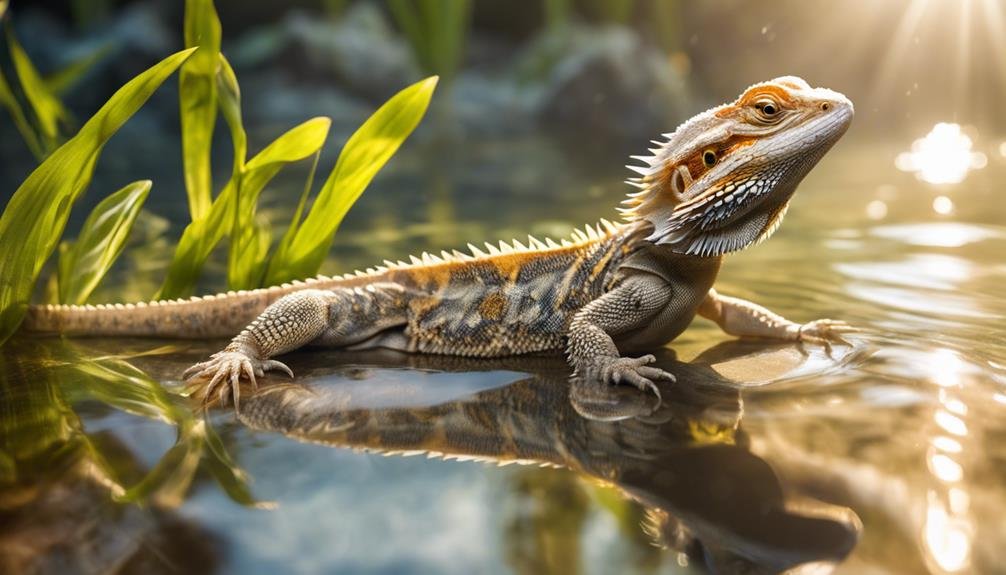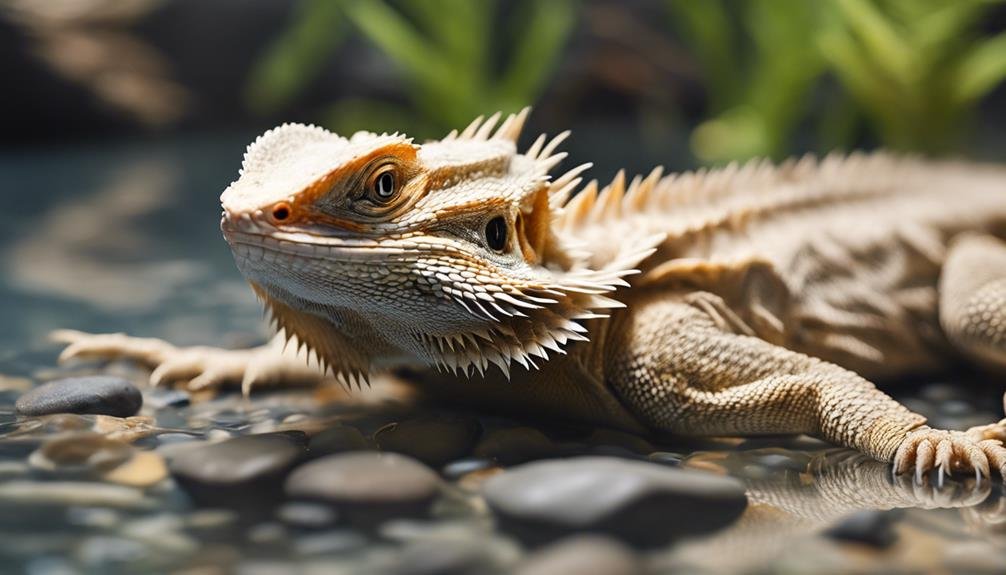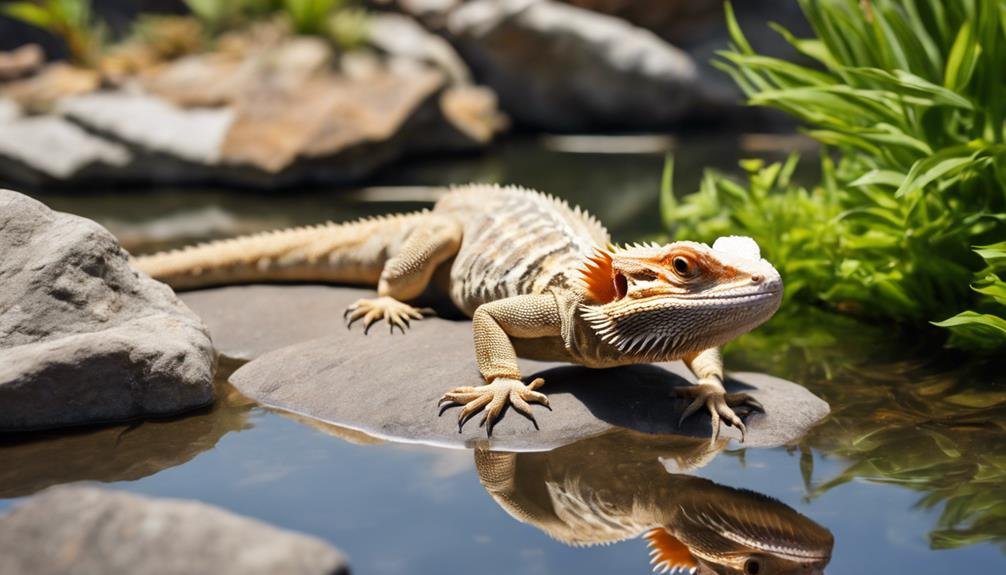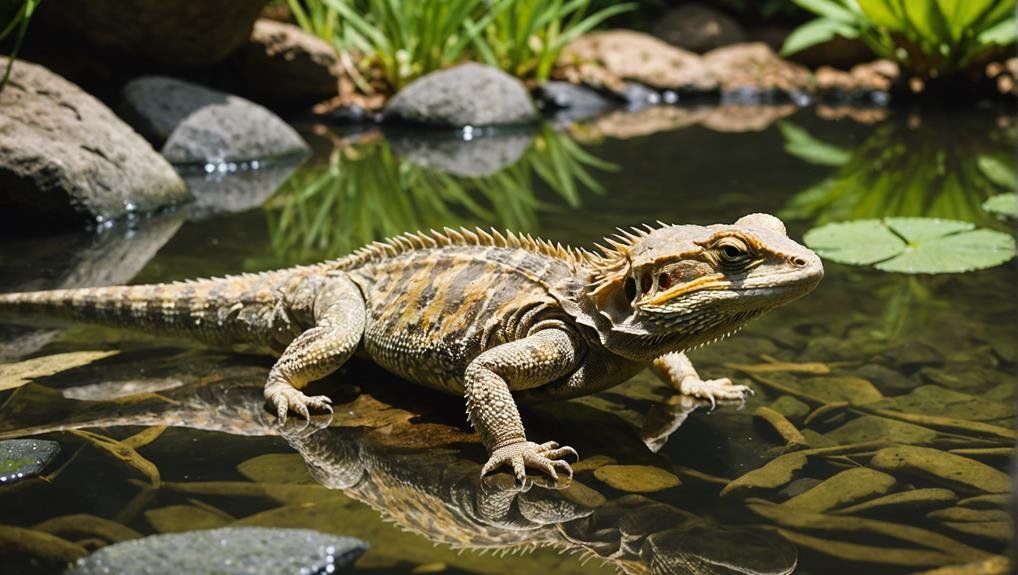You might be surprised to learn that bearded dragons can swim, using their limbs to paddle efficiently in water. They even inflate themselves to float, aiding in buoyancy. Yet, while these reptiles have some aquatic abilities, it’s important to comprehend the advantages and risks involved. Have you ever wondered how to provide a safe swimming environment for your bearded dragon? There are specific steps and precautions you need to take into account. Let’s explore what makes swimming potentially advantageous and how to guarantee your pet’s safety.
Key Takeaways
- Bearded dragons are capable swimmers and can paddle using their limbs.
- They can float by inflating themselves with air, aiding in buoyancy.
- Swimming provides excellent exercise and mental stimulation for bearded dragons.
- Always supervise swim sessions in shallow water for safety.
- Proper post-swim care includes drying the dragon and adjusting cage temperatures.
Bearded Dragons’ Swimming Abilities


When discussing bearded dragons’ swimming capabilities, you’ll be amazed at how capable these reptiles are in the water. Bearded dragons swimming isn’t just a rare sight; it’s a natural behavior for these fascinating creatures. They use their limbs to paddle efficiently and can even float by inflating themselves with air. This buoyancy helps them stay on the water’s surface while swimming.
If you ever let your beardie take a dip in a swimming pool or a shallow basin, you’ll notice they can swim quite well. It’s important to keep an eye on them to guarantee their safety, as accidents can happen. Some dragons might be hesitant at first but generally, they warm up to the idea and enjoy their time in the water.
Interestingly, bearded dragons can swim underwater for short periods. They might also take the opportunity to drink water while they’re at it, so don’t be alarmed if you see your beardie dipping its mouth in the water.
Benefits of Swimming
Swimming offers a range of benefits for bearded dragons, making it a valuable activity to incorporate into their routine. First and foremost, swimming provides excellent exercise, promoting muscle development and overall health. This physical activity can help keep your bearded dragon in good shape and active.
Additionally, swimming serves as a form of mental stimulation, engaging their curiosity and giving them a break from their usual environment.
Shedding is another area where swimming proves advantageous. Water helps keep their skin hydrated, making the shedding process smoother and less stressful. This can prevent issues like retained shed, which can cause discomfort or health problems.
Moreover, swimming can be a wonderful bonding activity. Spending supervised swim time with your bearded dragon strengthens your relationship and provides them with a sense of security. Just make sure they’re always in shallow, safe water to avoid any risks.
Safety Measures


While swimming offers numerous benefits for bearded dragons, it’s vital to prioritize their safety to guarantee a positive experience.
First, always use a shallow water container for swimming. This helps prevent dragons swimming accidents and reduces the risks to dragons that deep water poses.
You should also engage in water temperature monitoring to make sure it’s neither too hot nor too cold, as extreme temperatures can stress or shock your pet.
It’s important to avoid deep water. Bearded dragons aren’t natural swimmers, and deep bodies of water can be hazardous. If your dragon shows signs of discomfort, such as frantic movements or attempting to escape, never force them to continue swimming. It’s crucial to respect their boundaries to maintain their trust and well-being.
After swimming, thoroughly dry your dragon. This step helps regulate their body temperature, preventing them from getting too cold, which can lead to health issues.
Suitable Swimming Environments
For a safe and enjoyable swimming experience, choose small kiddie pools or plastic bins as suitable environments for your bearded dragon. These controlled spaces are ideal as they prevent your dragon from trying to swim in deep water, which can pose drowning risks.
When selecting a kiddie pool or plastic bin, make sure it’s at least twice the length of your dragon. This provides ample swimming space and allows your pet to move freely without feeling cramped.
It’s important to regularly clean and maintain the swimming space. This helps prevent contamination and keeps your dragon healthy. Use mild, reptile-safe cleaning agents and rinse thoroughly to remove any residue.
Always supervise your dragon while it swims to prevent accidents. Even in shallow water, your dragon may become fatigued or encounter unexpected issues.
To further guarantee safety, avoid exposing your bearded dragon to deep bodies of water. Their natural habitats don’t include swimming in deep water, and it can be overwhelming for them.
Common Risks and Precautions


When letting your bearded dragon swim, several common risks demand your attention to guarantee their safety. One of the primary concerns is aspirating water, which can lead to serious respiratory issues. It’s vital to monitor for water aspiration symptoms such as coughing or choking sounds. If these symptoms occur, don’t hesitate to seek vet assistance.
After swimming, be mindful of your dragon’s recovery by adjusting their cage temperatures. Warmer temperatures can assist in alleviating any effects of water aspiration.
Supervision is crucial when your bearded dragons swim to prevent drowning due to exhaustion. Here are some key precautions to ensure their safety:
- Monitor swimming duration: Keep swim sessions brief to avoid fatigue.
- Check water depth: Ensure the water level isn’t too deep; it should be shallow enough for your dragon to stand comfortably.
- Stay alert for water aspiration symptoms: Be prepared to act if your dragon shows signs of difficulty.
- Adjust cage temperatures post-swim: Warmer temperatures can aid in recovery.
- Seek vet assistance if necessary: Don’t delay seeking professional help if you notice persistent respiratory issues.
Frequently Asked Questions
Is It Good to Let Your Bearded Dragon Swim?
Yes, letting your bearded dragon swim has swimming benefits like exercise and hydration. Guarantee water safety with proper swim supervision, water temperature, and depth. Limit swim frequency, include bath time, and always dry off afterward.
Is It Okay to Put a Bearded Dragon in Water?
Yes, it’s okay to put a bearded dragon in water, but you must guarantee water safety. Swimming benefits include confidence building and exercise. Proper supervision is essential to avoid health risks. Consider their aquatic instincts and natural habitats.
Can Beardies Breathe Underwater?
Your beardie can’t breathe underwater. They lack respiratory adaptations for underwater breathing. Focus on water safety and monitor their diving behavior. Make sure they use their aquatic instincts and swimming techniques, and enjoy water play without submerging too long.
Do Bearded Dragons Recognize Their Owners?
Yes, bearded dragons recognize their owners using pet recognition and visual memory. Through human interaction, they exhibit behavioral cues and emotional responses. Owner bonding fosters social connection, enhancing reptile relationships and showcasing their cognitive abilities to recognize familiar faces.
Conclusion
To sum up, bearded dragons can indeed swim and even find pleasure in it, with numerous advantages like physical activity and staying hydrated. However, it’s essential to guarantee their safety by offering a shallow, closely monitored swimming area. Always stay alert to prevent possible dangers like drowning or excessive strain. By following these measures, you can allow your bearded dragon to relish the water securely, enriching their existence and improving their overall health. So, invite your dragon to take a swim, but remain attentive!

